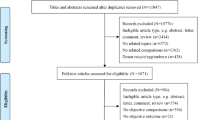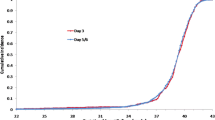Abstract
The superiority of the cumulative outcomes of day 5/6 embryo transfer to those of day 2/3 embryo transfer in infertile couples has been debated. This retrospective study included data collected from 1051 patients from July 2011 to June 2014. Multiple maternal baseline covariates were subjected to propensity score matching analysis, and each day 5/6 group woman was matched to one day 2/3 group woman. A systematic meta-analysis was conducted to validate the results. After matching was completed, 217 patients on the day 2/3 group were matched with those on the day 5/6 group, and no significant differences in the baseline characteristics were observed between the two groups. The cumulative pregnancy rate (57.14% vs. 53.46%, OR 1.16, 95% CI 0.79–1.70) and cumulative live birth rate (53.00% vs. 49.77%, OR 1.14, 95% CI 0.78–1.66) of day 5/6 embryo transfers were higher than those of day 2/3 embryo transfers, but this difference was not significant. The mean cycles per live birth and mean days per live birth in the day 5/6 group were significantly lower than those in the day 2/3 group. This study demonstrated that day 5/6 embryo transfer is a more cost-effective and time-efficient policy than day 2/3 embryo transfer to produce a live baby.
Similar content being viewed by others
References
Gardner DK, Schoolcraft WB, Wagley L, Schlenker T, Stevens J, Hesla J. A prospective randomized trial of blastocyst culture and transfer in in-vitro fertilization. Hum Reprod 1998; 13(12): 3434–3440
Hsieh YY, Tsai HD, Chang FC. Routine blastocyst culture and transfer: 201 patients’ experience. J Assist Reprod Genet 2000; 17(8): 405–408
Van der Auwera I, Debrock S, Spiessens C, Afschrift H, Bakelants E, Meuleman C, Meeuwis L, D’Hooghe TM. A prospective randomized study: day 2 versus day 5 embryo transfer. Hum Reprod 2002; 17(6): 1507–1512
Smith LP, Oskowitz SP, Dodge LE, Hacker MR. Risk of ectopic pregnancy following day-5 embryo transfer compared with day-3 transfer. Reprod Biomed Online 2013; 27(4): 407–413
Huang B, Hu D, Qian K, Ai J, Li Y, Jin L, Zhu G, Zhang H. Is frozen embryo transfer cycle associated with a significantly lower incidence of ectopic pregnancy? An analysis of more than 30,000 cycles. Fertil Steril 2014; 102(5): 1345–1349
Alper MM, Brinsden P, Fischer R, Wikland M. To blastocyst or not to blastocyst? That is the question. Hum Reprod 2001; 16(4): 617–619
Tsirigotis M. Blastocyst stage transfer: pitfalls and benefits. Too soon to abandon current practice? Hum Reprod 1998; 13(12): 3285–3289
Glujovsky D, Blake D, Farquhar C, Bardach A. Cleavage stage versus blastocyst stage embryo transfer in assisted reproductive technology. Cochrane Database Syst Rev 2012; 7(7): CD002118
Barnhart KT. Introduction: are we ready to eliminate the transfer of fresh embryos in in vitro fertilization? Fertil Steril 2014; 102(1): 1–2
Lintsen AME, Braat DDM, Habbema JDF, Kremer JAM, Eijkemans MJC. Can differences in IVF success rates between centres be explained by patient characteristics and sample size? Hum Reprod 2010; 25(1): 110–117
Bodri D, Kawachiya S, De Brucker M, Tournaye H, Kondo M, Kato R, Matsumoto T. Cumulative success rates following mild IVF in unselected infertile patients: a 3-year, single-centre cohort study. Reprod Biomed Online 2014; 28(5): 572–581
Trokoudes KM, Pavlides C, Zhang X. Comparison outcome of fresh and vitrified donor oocytes in an egg-sharing donation program. Fertil Steril 2011; 95(6): 1996–2000
Cobo A, de los Santos MJ, Castellò D, Gámiz P, Campos P, Remohí J. Outcomes of vitrified early cleavage-stage and blastocyst-stage embryos in a cryopreservation program: evaluation of 3,150 warming cycles. Fertil Steril 2012; 98(5): 1138–1146.e1
Loutradi KE, Kolibianakis EM, Venetis CA, Papanikolaou EG, Pados G, Bontis I, Tarlatzis BC. Cryopreservation of human embryos by vitrification or slow freezing: a systematic review and meta-analysis. Fertil Steril 2008; 90(1): 186–193
AbdelHafez FF, Desai N, Abou-Setta AM, Falcone T, Goldfarb J. Slow freezing, vitrification and ultra-rapid freezing of human embryos: a systematic review and meta-analysis. Reprod Biomed Online 2010; 20(2): 209–222
Gleicher N, Kushnir VA, Barad DH. Is it time for a paradigm shift in understanding embryo selection? Reprod Biol Endocrinol 2015; 13(1): 3
Xi QS, Zhu LX, Hu J, Wu L, Zhang HW. Should few retrieved oocytes be as an indication for intracytoplasmic sperm injection? J Zhejiang Univ Sci B 2012; 13(9): 717–722
Yu Z, Dong X, Rui W, Wei Y, Zhang H, Zhu G, Ai J. The criteria for optimal down-regulation with gonadotropin-releasing hormoneagonist: a retrospective cohort study. Gynecol Endocrinol 2015; 31(12): 959–965
Papanikolaou EGD, D’haeseleer E, Verheyen G, Van de Velde H, Camus M, Van Steirteghem A, Devroey P, Tournaye H. Live birth rate is significantly higher after blastocyst transfer than after cleavage-stage embryo transfer when at least four embryos are available on day 3 of embryo culture. A randomized prospective study. Hum Reprod 2005; 20(11): 3198–3203
Yu Z, Dong X, Wei Y, Zhang H, Ai J. The artificial cycle method improves the pregnancy outcome in freeze–thawed embryo transfer: a retrospective cohort study. Gynecol Endocrinol 2015; 31(1): 70–74
Huang B, Ren X, Wu L, Zhu L, Xu B, Li Y, Ai J, Jin L. Elevated progesterone levels on the day of oocyte maturation may affect top quality embryo IVF cycles. PLoS One 2016; 11(1): e0145895
Elgindy EA, Abou-Setta AM, Mostafa MI. Blastocyst-stage versus cleavage-stage embryo transfer in women with high oestradiol concentrations: randomized controlled trial. Reprod Biomed Online 2011; 23(6): 789–798
Emiliani S, Delbaere A, Vannin AS, Biramane J, Verdoodt M, Englert Y, Devreker F. Similar delivery rates in a blastocyst cryopreservation to optimize outcomes of warming cycles 159 selected group of patients, for day 2 and day 5 embryos both cultured in sequential medium: a randomized study. Hum Reprod 2003; 18(10): 2145–2150
Rienzi L, Ubaldi F, Iacobelli M, Ferrero S, Minasi MG, Martinez F, Tesarik J, Greco E. Day 3 embryo transfer with combined evaluation at the pronuclear and cleavage stages compares favourably with day 5 blastocyst transfer. Hum Reprod 2002; 17(7): 1852–1855
Fernández-Shaw S, Cercas R, Braña C, Villas C, Pons I. Ongoing and cumulative pregnancy rate after cleavage-stage versus blastocyst- stage embryo transfer using vitrification for cryopreservation: impact of age on the results. J Assist Reprod Genet 2015; 32(2): 177–184
Acknowledgements
This work was supported by the Ministry of Health Public Foundation of China (No.201402004), National Basic Research Program of China (973 Program, No. 2007CB948104), Huazhong University of Science and Technology Independent Innovation Research Fund (No. 2013ZHYX010), Specialized Research Fund for the Commission of Hubei Province (No. JS-2011002), and National Natural Science Foundation of China (No. 81601348).
Author information
Authors and Affiliations
Corresponding author
Electronic supplementary material
Rights and permissions
About this article
Cite this article
Yin, Y., Chen, G., Li, K. et al. Propensity score-matched study and meta-analysis of cumulative outcomes of day 2/3 versus day 5/6 embryo transfers. Front. Med. 11, 563–569 (2017). https://doi.org/10.1007/s11684-017-0535-6
Received:
Accepted:
Published:
Issue Date:
DOI: https://doi.org/10.1007/s11684-017-0535-6




